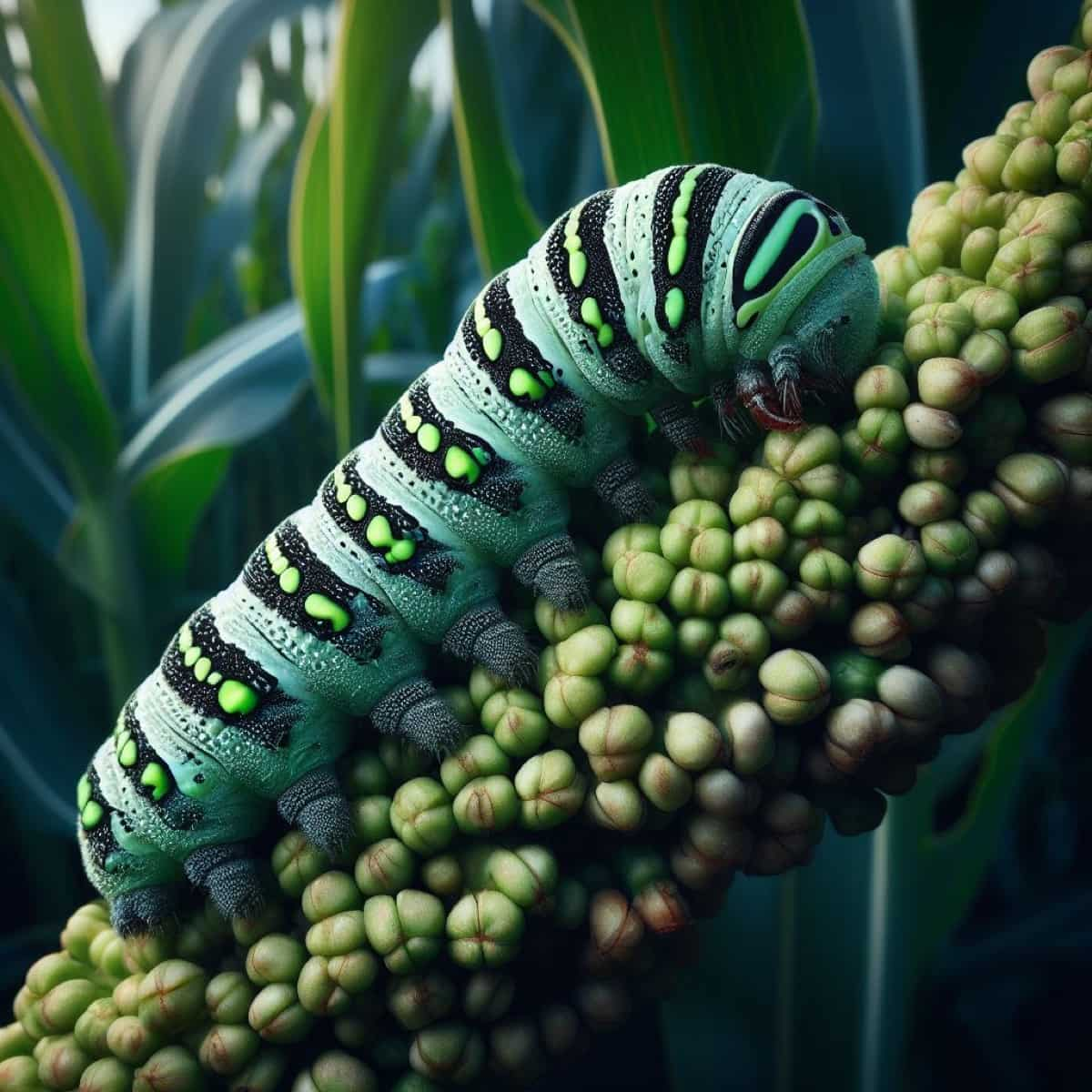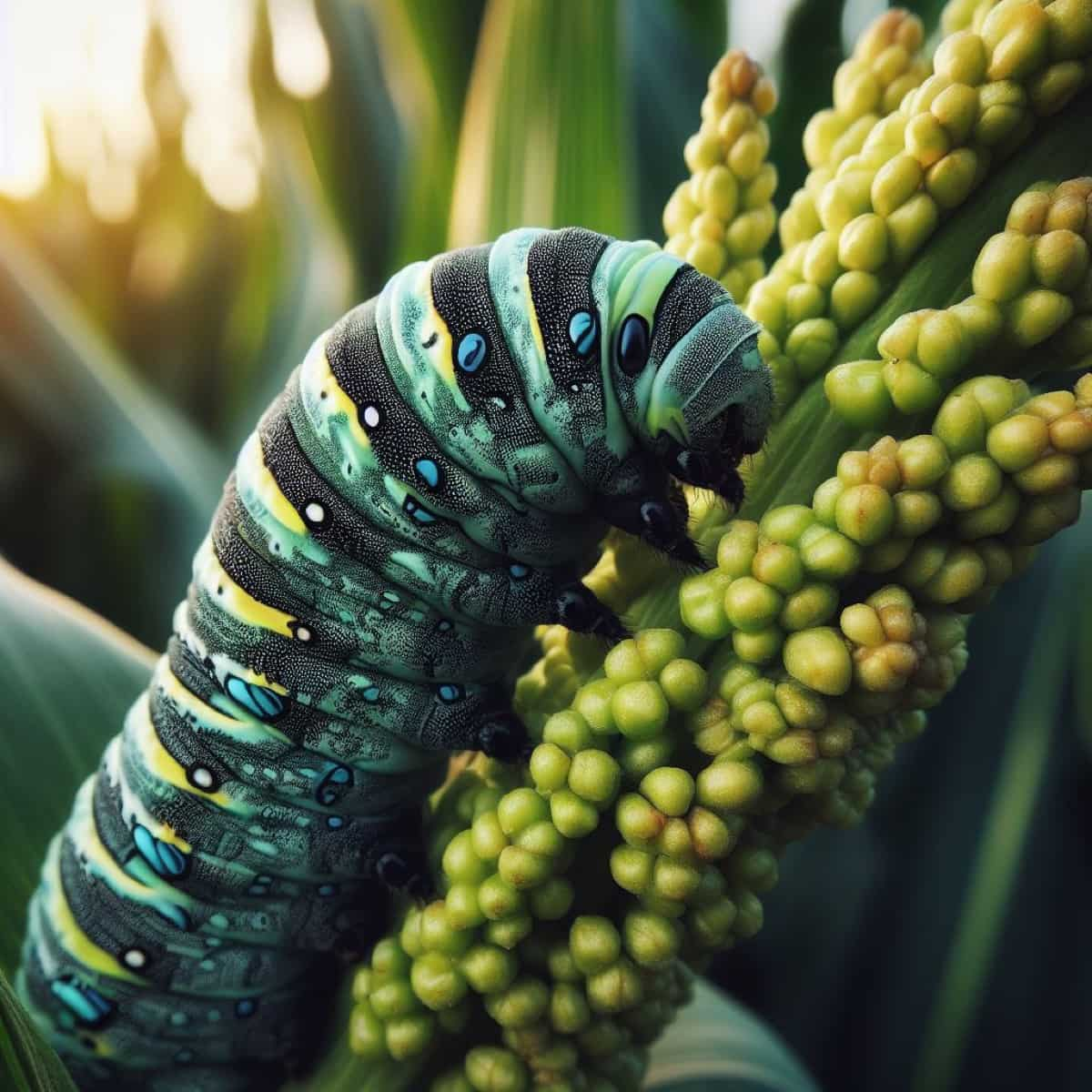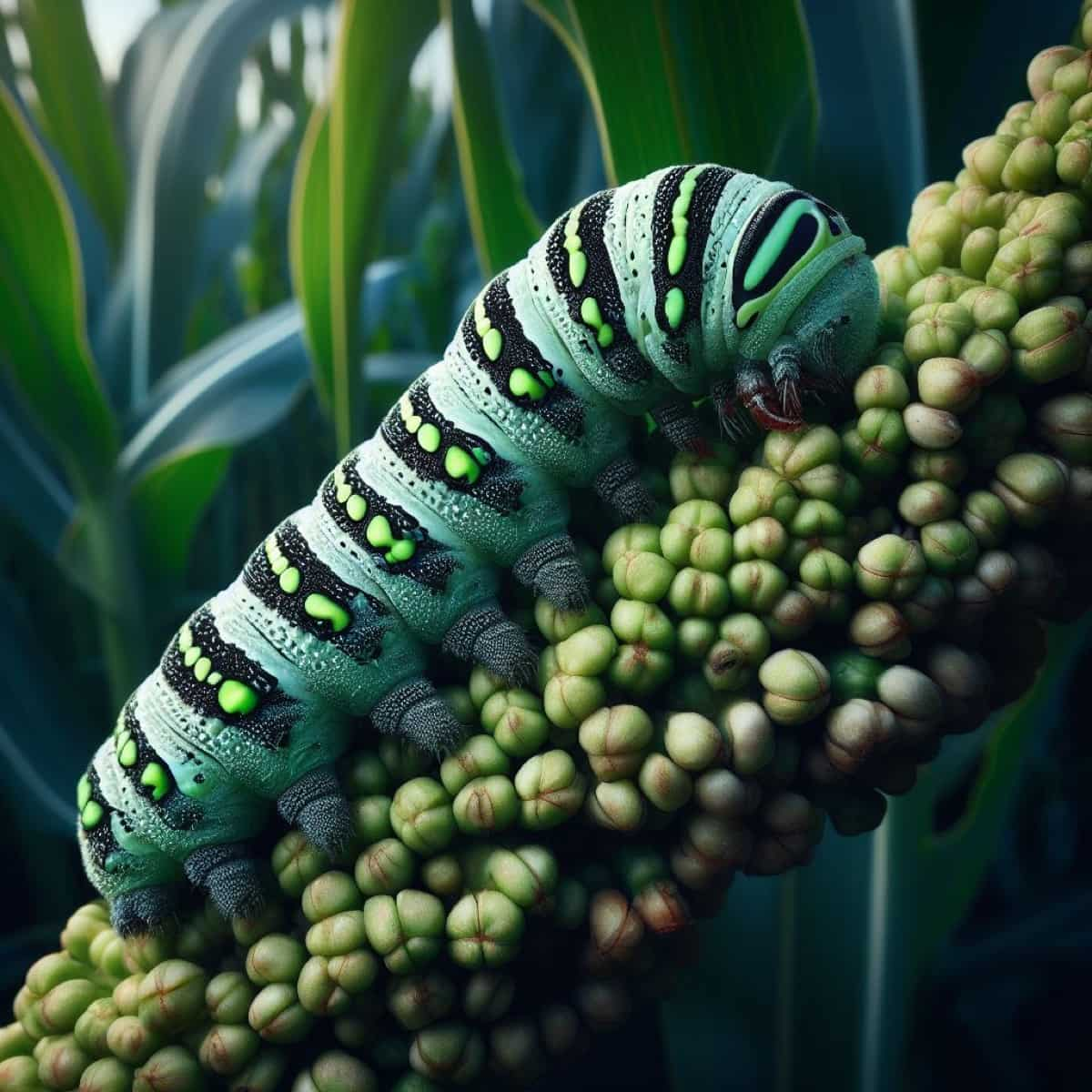The Fall Armyworm, scientifically known as Spodoptera frugiperda, is a highly mobile caterpillar renowned for its long-distance migration from the southern United States to northern regions, including Canada, during late summer and early fall. These caterpillars are characterized by their voracious appetite and the ability to rapidly devour crops such as corn, sorghum, and other grass crops.

Typically, fall armyworm caterpillars measure up to 2 inches in length and often congregate in groups. Prompt action is crucial if you suspect an infestation, as early removal of caterpillars can minimize damage.
How to Control Fall Armyworm in Sorghum
Fall Armyworm Symptoms in Sorghum
When Fall Armyworms (Spodoptera frugiperda) attack sorghum crops, they can do much damage. Early detection of the signs is key to effective treatment.
- Damage to the leaves: Sorghum leaves with irregular patterns or holes resembling window panes. Feeding breaks down leaves into skeletons, making them look torn.
- Loss of leaves: When there are severe outbreaks, plants lose many leaves, making it harder to make food through photosynthesis.
- Marks from scraping: Young caterpillars leave silvery-white marks on the leaves before they move on to more destructive eating.
- Frass (God’s Waste): Finding small, dark green or black pellets on leaves. These are caterpillar droppings.
- Going wilty and stunting: Infested plants may wilt, turn yellow, or grow slowly because they lose nutrients and damage their growing points.
- Damage to the tassels and panicles: Caterpillars can eat through the tassel or flower and hurt the reproductive parts.
- Plant Lodging: Sorghum plants can lodge or bend over if many pests eat their roots
Cultural Control Methods of Fall Armyworm in Sorghum
- Rotation of Crops: Rotate sorghum with non-host crops such as legumes or grasses to disrupt the pest’s life cycle. Avoid consecutive sorghum plantings in the same field to prevent the establishment of autumn armyworm populations.
- Planting in the early stages: Plant sorghum early in the growing season to avoid peak Fall Armyworm infestations. Sorghum can establish itself before autumn armyworm numbers become strong.
- Trap Plants: Plant trap crops around sorghum fields, such as maize or millet, to attract Fall Armyworms away from the main crop. To lessen pest pressure, monitor and maintain the trap crops regularly.
- Sanitation: After harvest, remove crop leftovers and weeds from the field to reduce overwintering sites for autumn armyworm pupae. To avoid pest survival, properly dispose of contaminated plant materials.
- Companion planting and interplanting: Combine sorghum with repellent crops or companion plants, such as marigolds, to discourage autumn armyworms. The pest’s host location and feeding behaviors can be disrupted by companion planting.
- Natural Enemies: Reduce pesticide use to encourage the presence of natural enemies like parasitoids and predators. To maintain beneficial insect populations, encourage biodiversity in and around sorghum fields.
- Monitoring: Scout sorghum fields regularly for the presence and extent of autumn armyworm damage. Implement pest control action thresholds to reduce economic losses.
- Agricultural Practices: To limit pest appeal and vulnerability, use recommended planting densities and spacing. To encourage healthy crop development and resilience, use suitable fertilization procedures.
Biological Control Methods of Fall Armyworm in Sorghum
To manage fall armyworms in sorghum fields, consider introducing natural predators like parasitic wasps, ladybugs, and birds, which eat Fall Armyworm eggs, larvae, and pupae, reducing pest numbers. Introduce or protect parasitoid wasps that lay their eggs inside fall armyworm caterpillars, which consume the caterpillar from within, killing it.
Use beneficial fungi as biopesticides, such as Beauveria bassiana and Metarhizium anisopliae, which infect and kill Fall Armyworm larvae. Use biological pesticides containing fall armyworm-specific Bacillus thuringiensis (Bt) toxins, which target and destroy larvae without harming beneficial insects or the environment. Finally, incorporate crop residue into the soil after harvest to encourage the breakdown of fall armyworm pupae.
Chemical Control Methods of Fall Armyworm in Sorghum
Fall Armyworm larvae can be targeted using synthetic insecticides like pyrethroids, organophosphates, or neonicotinoids, especially when populations exceed economic thresholds. Systemic insecticides, absorbed by plants and consumed by the bug while feeding on sorghum, provide long-term protection.
In case you missed it: Fertilizer Requirements and Recommendations for Sorghum: Management Practices for Optimal Yield

Insecticides should be applied during early larval stages, with regular scouting for optimal timing. To maximize performance and minimize environmental impact, follow pesticide label instructions, including dosage, application timing, and safety warnings.
Integrated Pest Management (IPM) strategies For Effective Fall Armyworm (FAW) Control in Sorghum
Before Sowing
- Deep plowing to expose pupae to sunlight.
- Maintain clean field bunds and plant flowering crops to attract natural enemies.
- Intercrop with Napier grass, pigeon pea, and cowpea.
Sowing and Post-Sowing
- Use ridge and furrow planting instead of flat sowing.
- The erect bird perches to encourage insectivorous birds.
- Apply balanced fertilizers to reduce FAW incidence.
- Practice clean cultivation by removing weed hosts.
- Treat seeds with Cyantraniliprole and Thiamethoxam.
Seedling Stage (0-30 days old crop)
- Spray neem formulations or Neem seed kernel extract.
- Hand collection and destruction of larvae and eggs.
- Use pheromone traps for mass trapping.
- Release parasitoids like Telenomus remus or Trichogramma pretiosum.
- Apply Bacillus thuringiensis or Metarhizium anisopliae for early instars.
- If the incidence exceeds 10%, use recommended synthetic pesticides.
Early Whorl Stage (30-50 days)
- Continue neem-based sprays.
- Apply Bacillus thuringiensis or Metarhizium anisopliae at 5-10% infestation.
- Use recommended synthetic pesticides if the incidence is 10-20%.
Late Whorl to Boot Stage (50-70 days)
No chemical intervention is needed unless the incidence exceeds 20%.
Integrated Pest Management (IPM) of Fall Armyworm in Sorghum
- Monitoring: Inspect sorghum fields regularly to assess autumn armyworm presence and population levels. Monitor adult moth activity with pheromone traps.
- Thresholds: Set action thresholds depending on pest density and crop stage to identify whether intervention is required.
- Cultural Practices: Crop rotation, early planting, and intercropping should all be used to disrupt Fall Armyworm life cycles. Reduce pest attraction by optimizing planting density and spacing.
- Biological Control: Encourage the presence of natural predators and parasitoids. To combat Fall Armyworms, use entomopathogenic fungi and helpful nematodes.
- Chemical Control: If chemical pesticides are required, use them as a last resort, following label directions and limiting harm to non-target creatures.
- Resistant Varieties: Choose sorghum types naturally resistant or tolerable to Fall Armyworm.
In case you missed it: From Seed to Harvest: How Farmers Plant and Grow Sorghum in Nebraska

Monitoring and Early Detection
Armyworms can attack at different stages of growth. Look for egg masses on the undersides of leaves or panicles, holes in leaves caused by larval feeding, and frass within the whorl of infested plants. Examine 50 randomly selected plants per acre across the entire field in a zigzag pattern, noting the percentage of plants affected in the whorl during the pre-bloom stage and any panicle damage.
To assess adult moth populations, use pheromone traps with the Universal Bucket Trap. Consider applying an insecticide if 20% of the plants exhibit signs of infestation or panicle damage. This proactive monitoring strategy ensures prompt action and reduces Fall Armyworm damage to sorghum crops.
Conclusion
Identifying and addressing Fall Armyworm infestations in sorghum is crucial. By recognizing symptoms early, such as ragged leaf edges and frass, and employing integrated pest management strategies, farmers can effectively combat this destructive pest and safeguard their sorghum crops.
- Feed Your Flock for Less: Top 10 Tips to Save on Chicken Feed
- Ultimate Guide to Ossabaw Island Hog: Breeding, Raising, Diet, and Care
- Hatching Answers: The Top 10 Reasons Your Chickens Aren’t Laying Eggs
- Eggs and Economics: Breaking Down the Cost of Raising Backyard Chickens
- Defend Your Greens: Proven Methods to Keep Iguanas Out of Your Garden
- Ultimate Guide to Cinnamon Queen Chicken: A Comprehensive Guide for Beginners
- Ultimate Guide to California Tan Chicken: Breeding, Raising, Diet, Egg-Production and Care
- Ultimate Guide to Marsh Daisy Chicken: Breeding, Raising, Diet, and Care
- 10 Types of Chicken Farming Businesses You Can Start for Profits